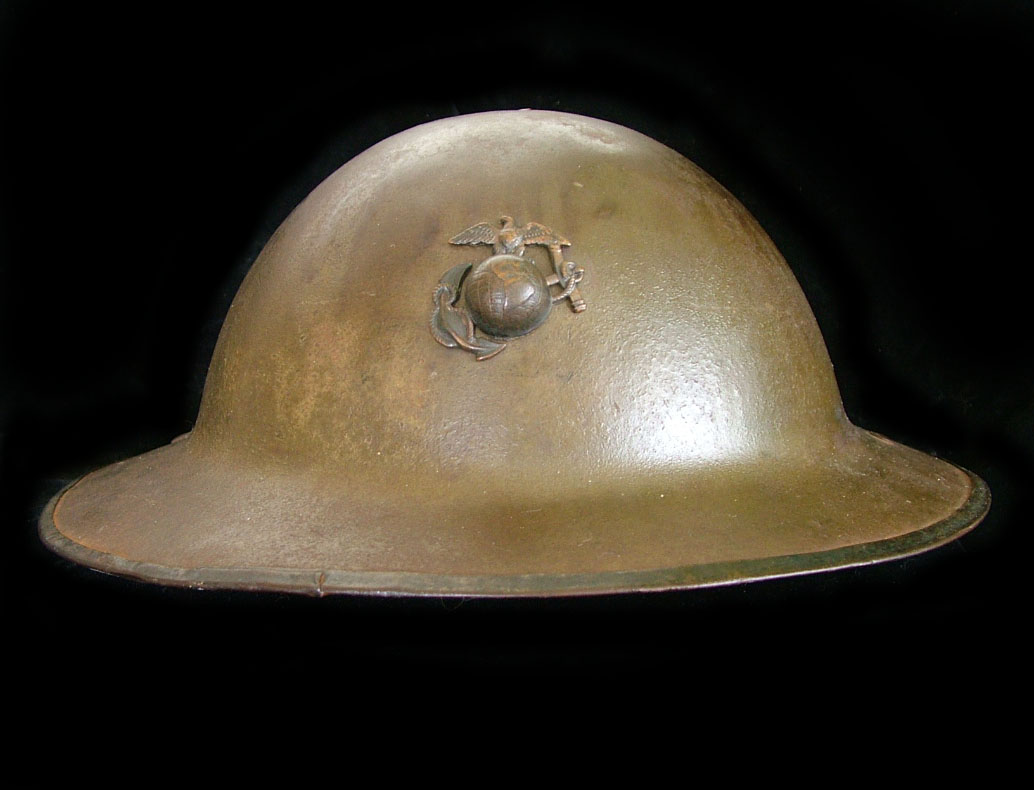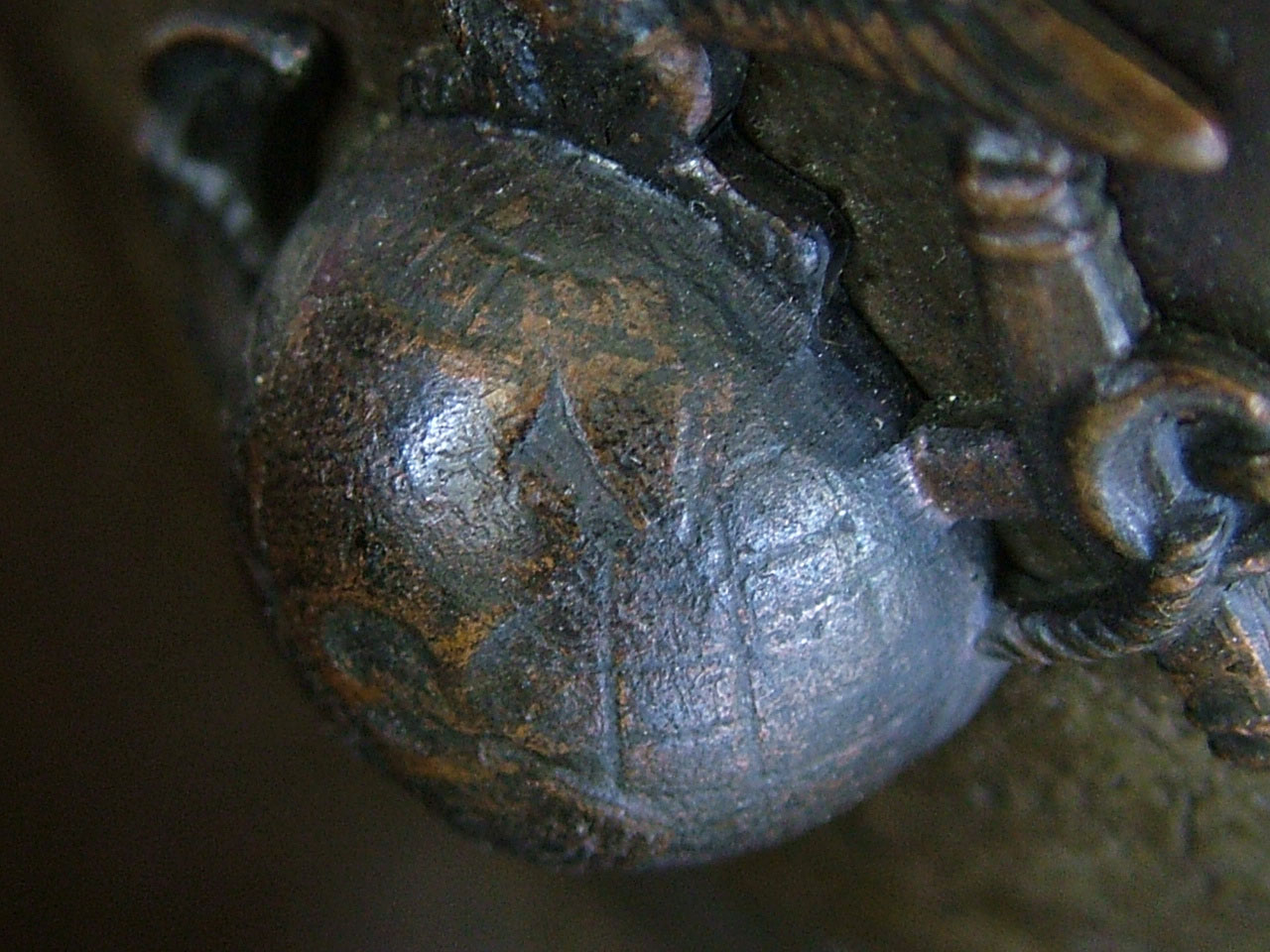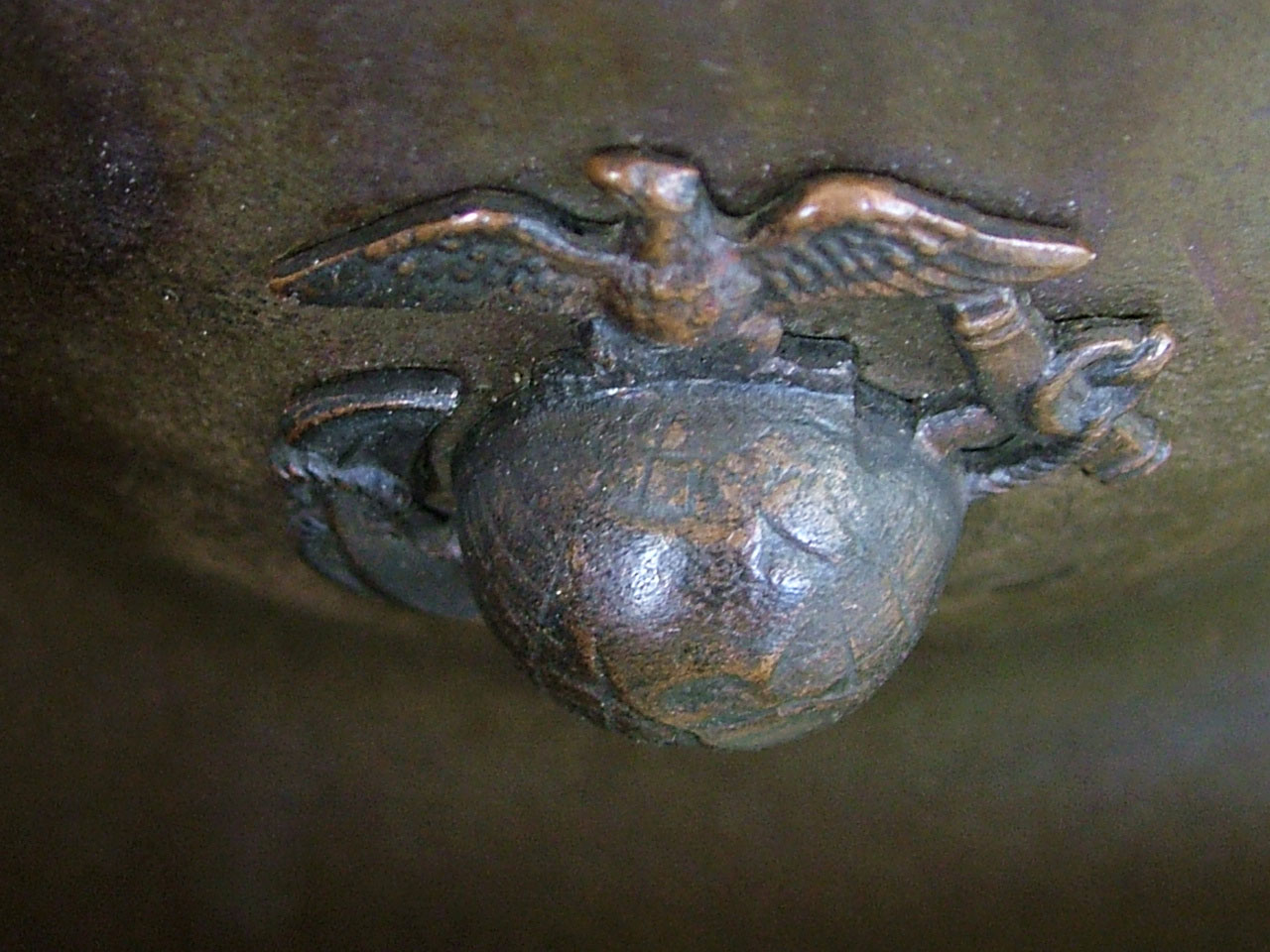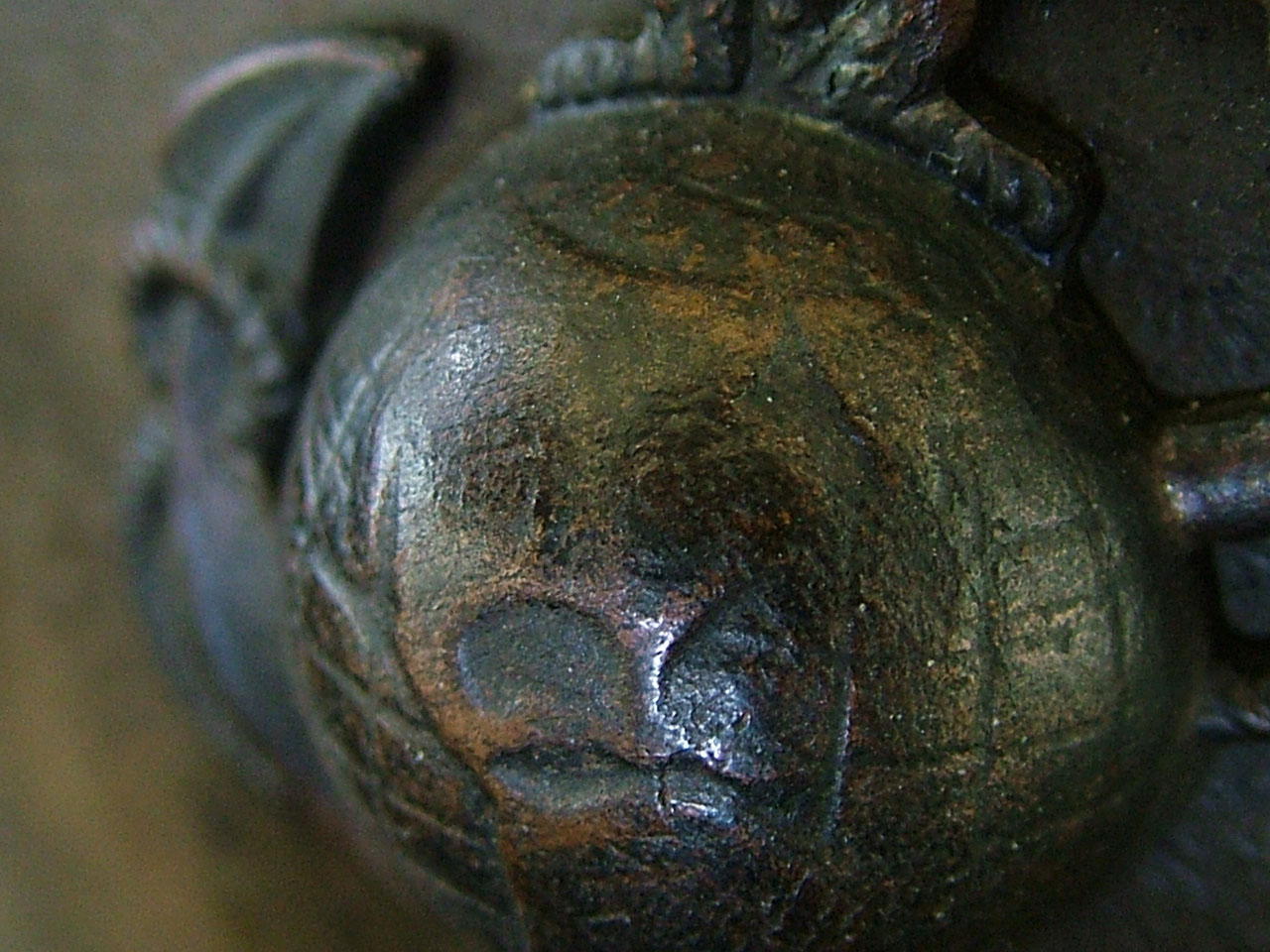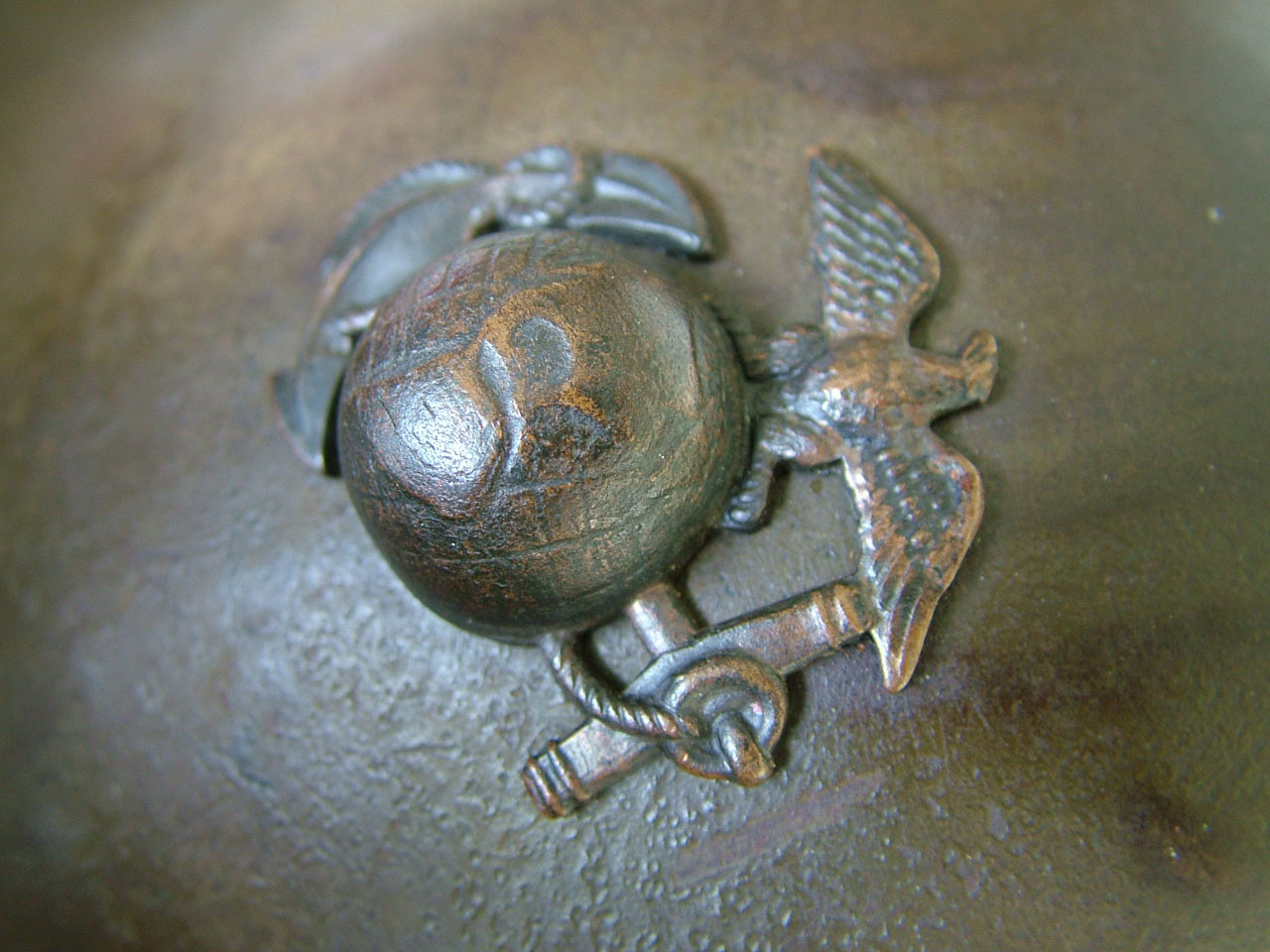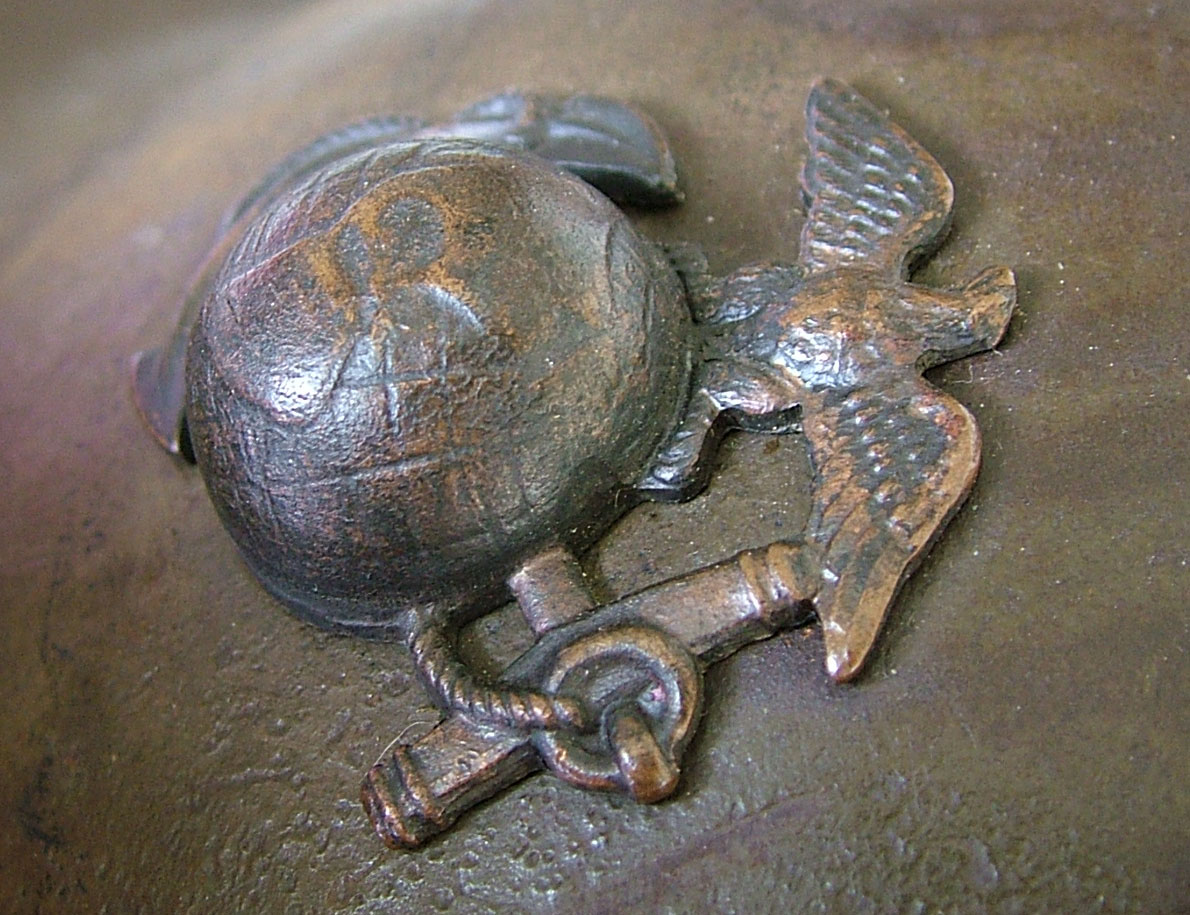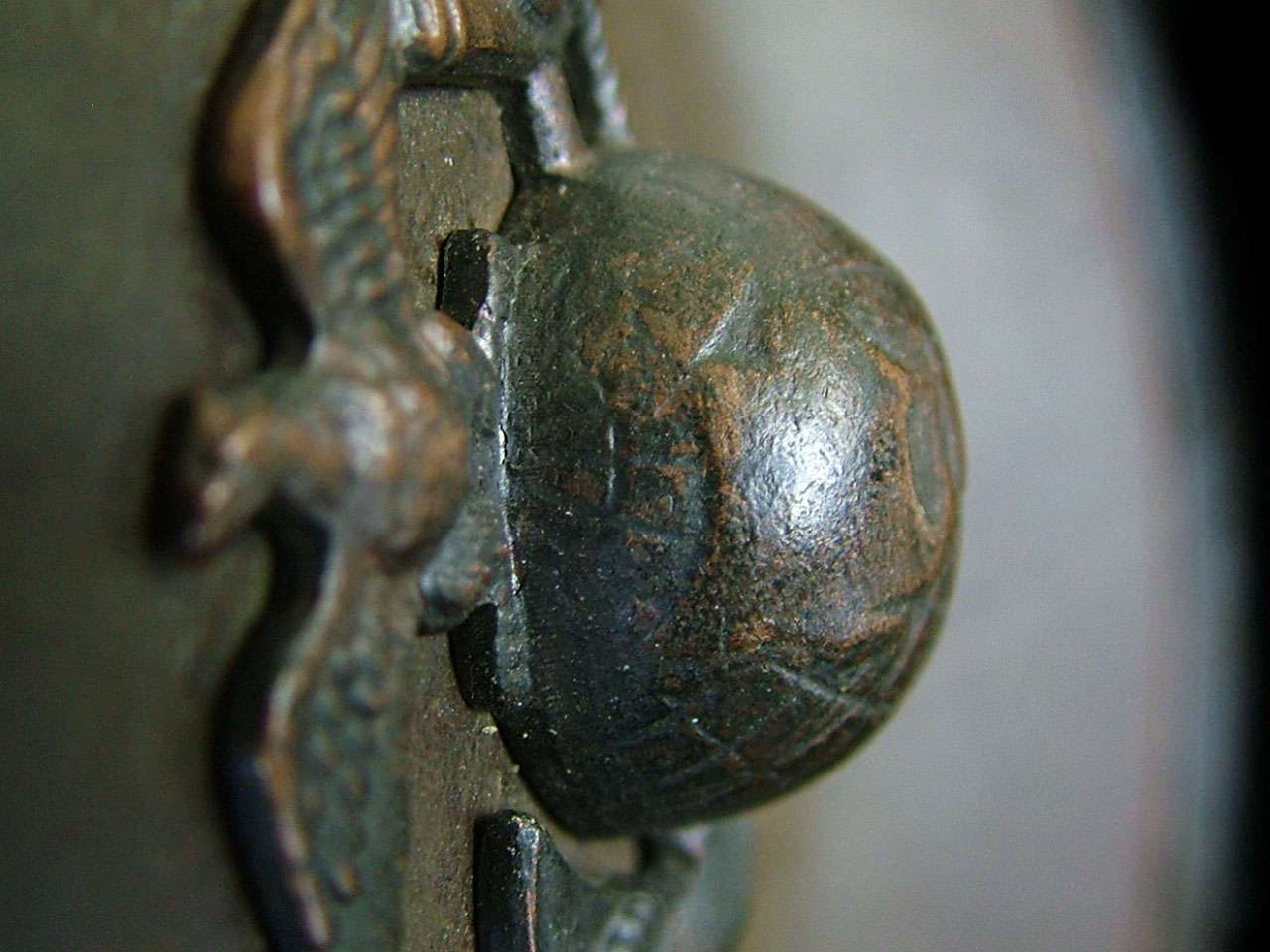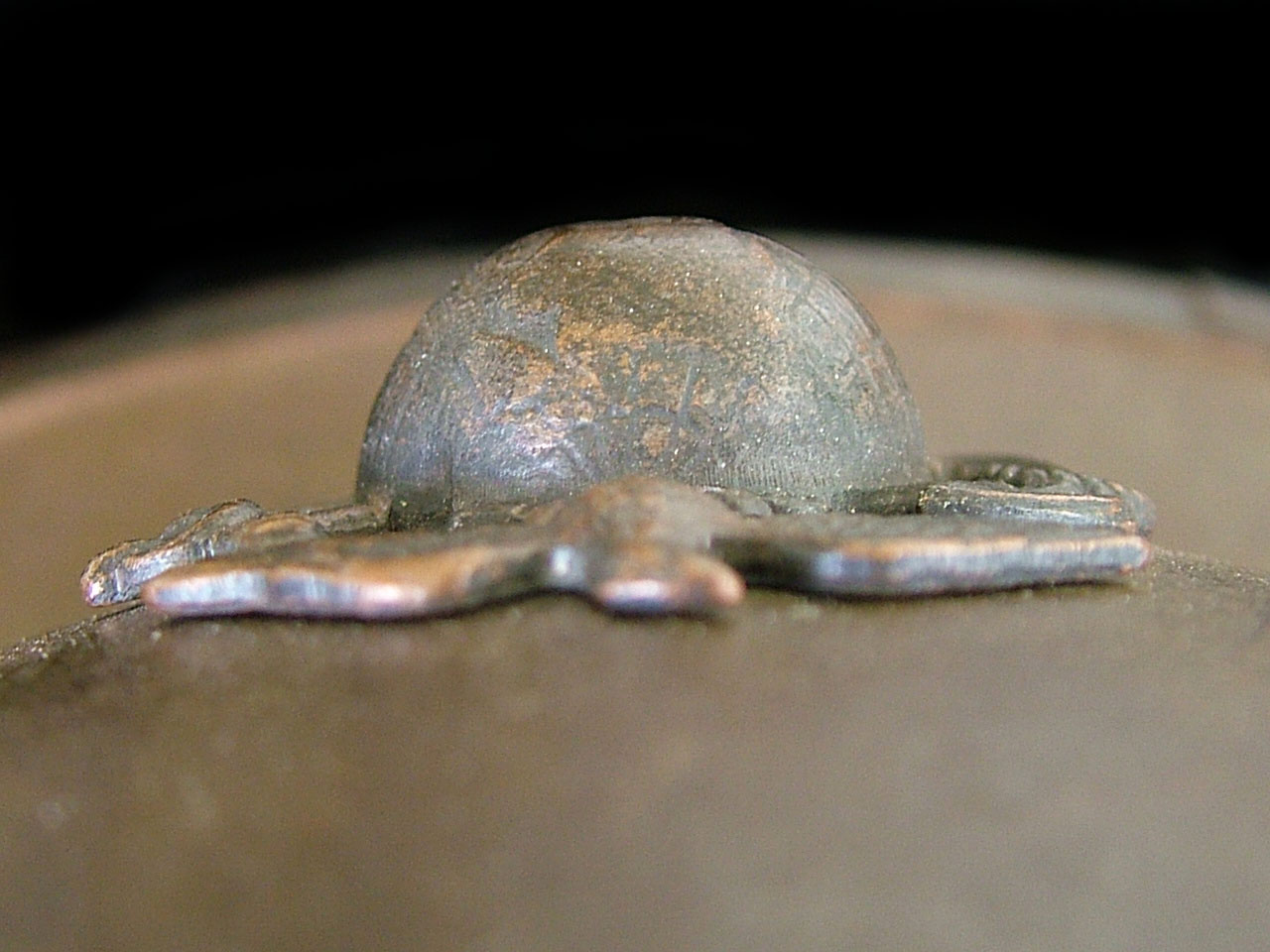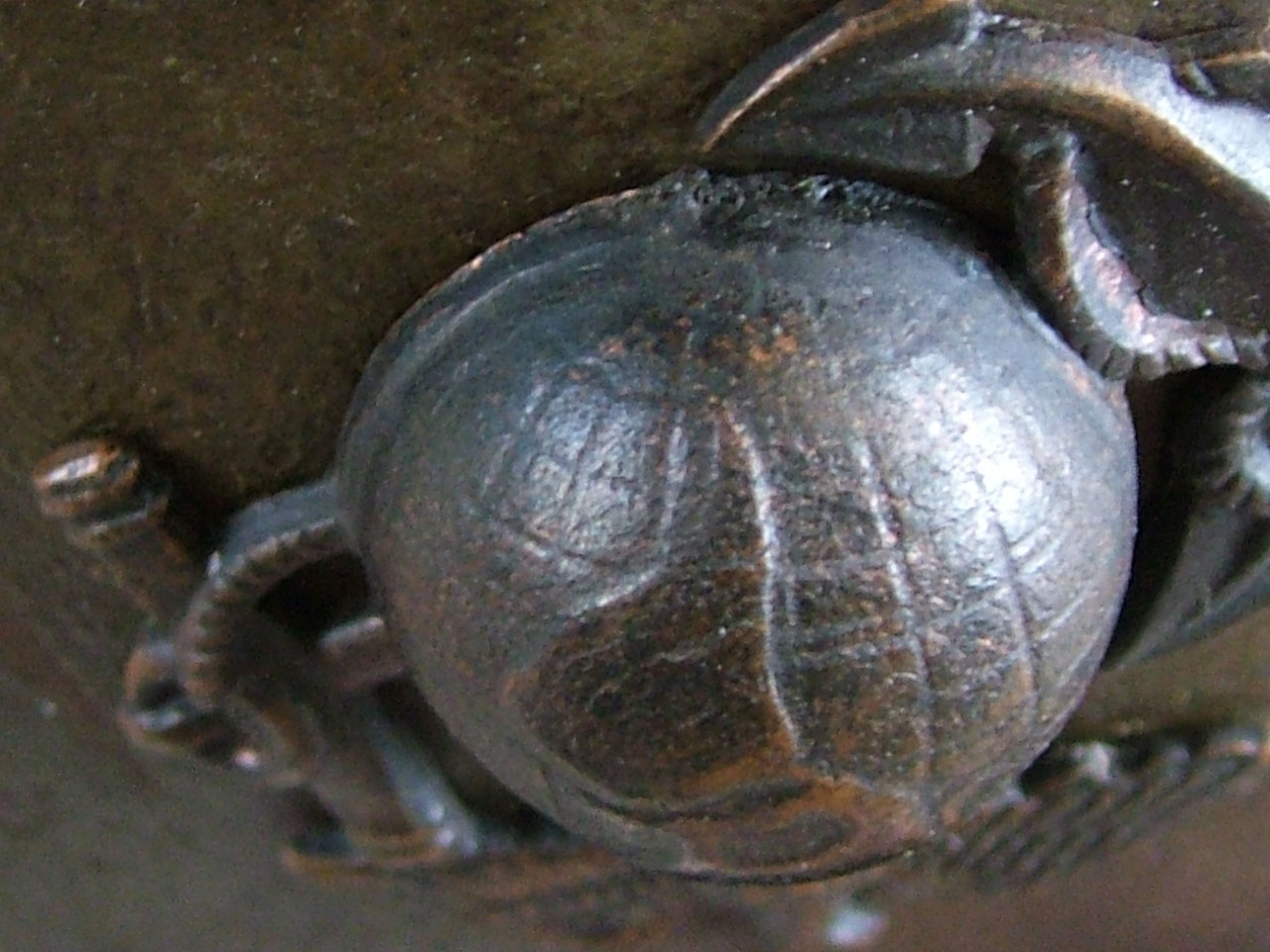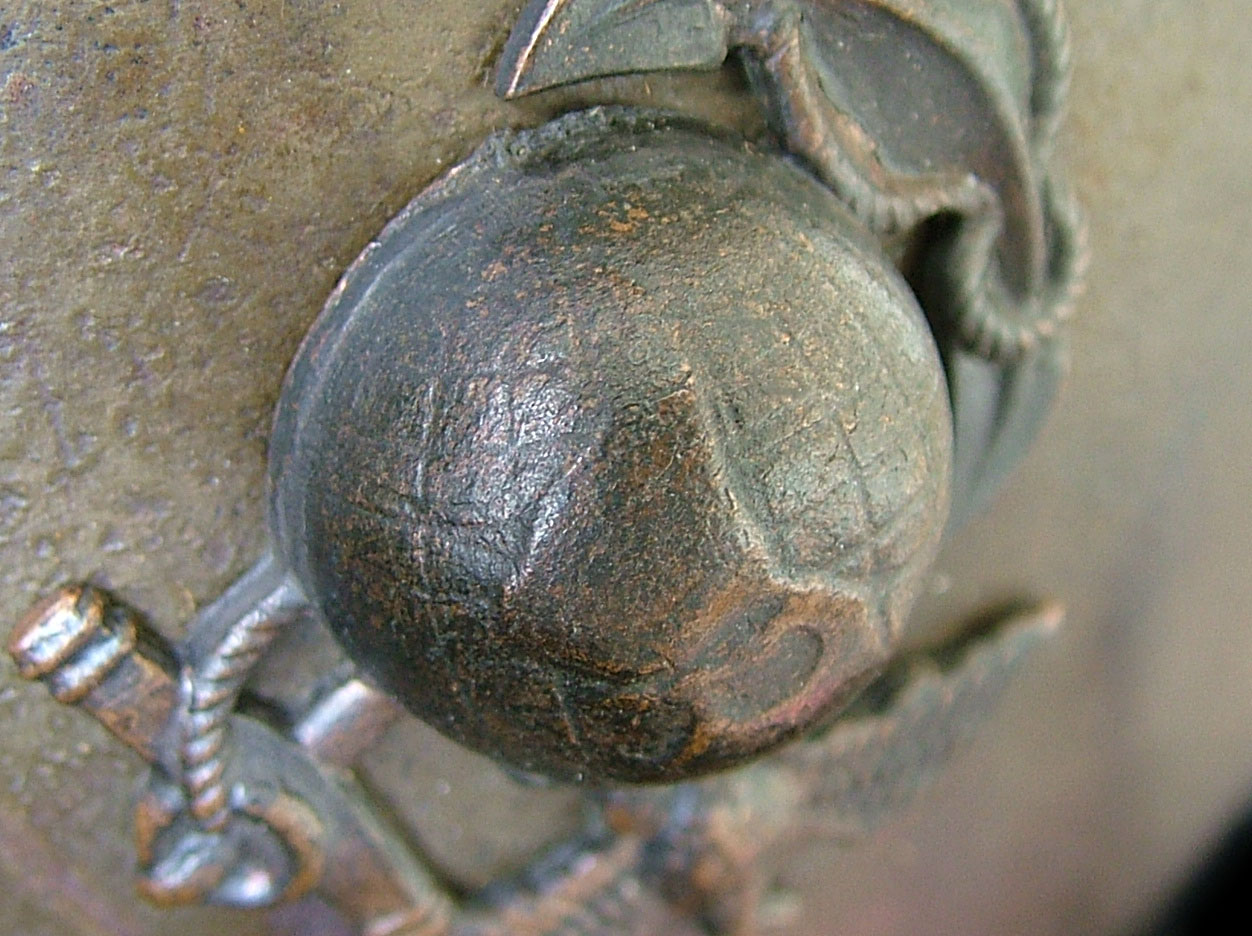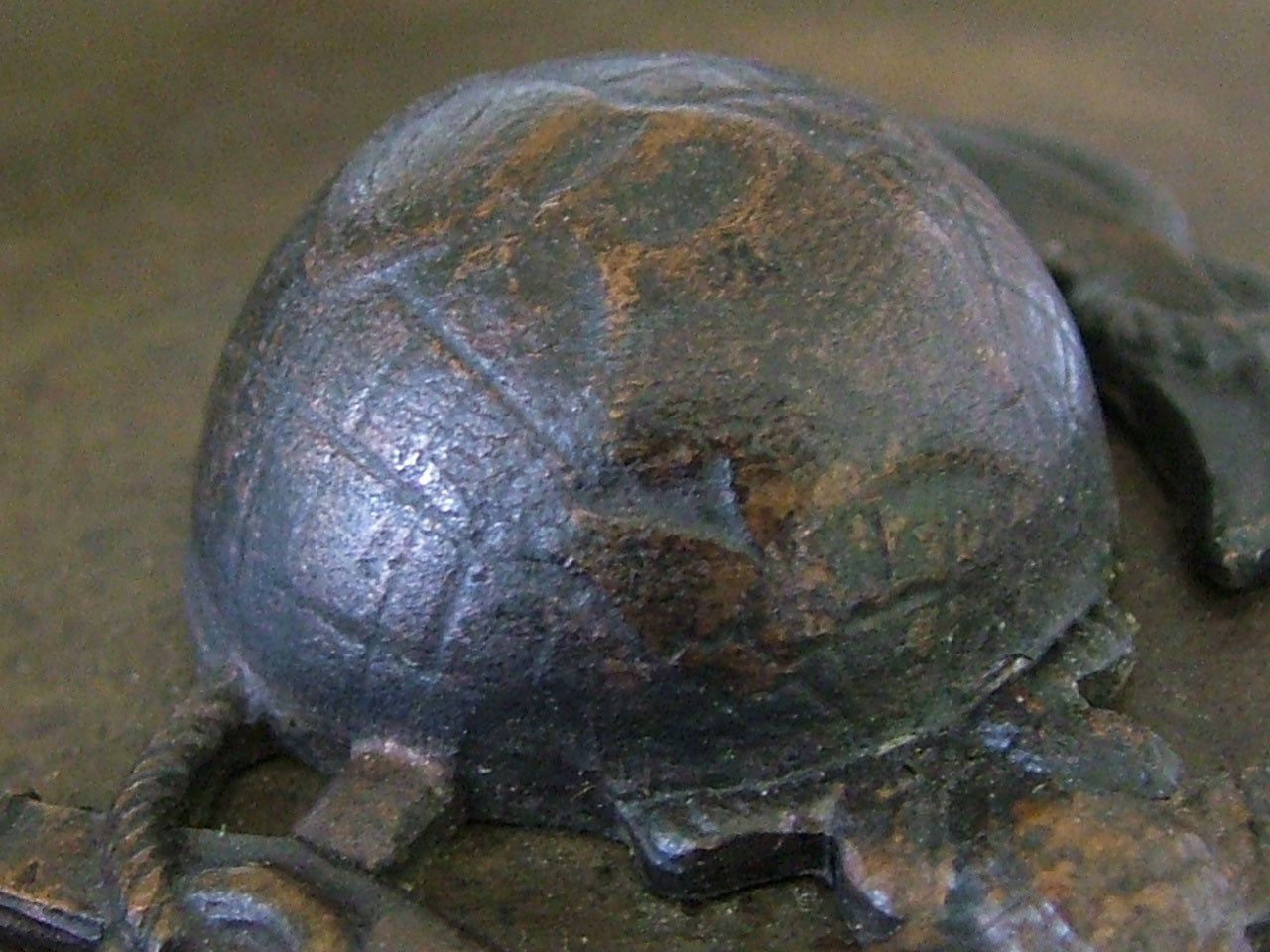 |
|---|
Devil Dog Helmet |
|
| THERE IS A LOT MORE INFO. TO BE POSTED WITH THIS ARTIFACT, AS WELL AS SOME EDITING AND THE ADDING OF MORE PHOTOS. |
|
| This is a U.S. Marine Corps M17 Helmet that apparently had been used by a Marine in France during WWI. It was purchased from a collector who had served in the Marine Corps, he informed me that the helmet had originally belonged to a Cpl. from Montana and that the Cpl. had been a veteran of the 5th Marine Regiment during WWI, he provided his name. The only other information that he knew or would offer is that the Cpl. had re-enlisted after the war and stationed at Marine Barracks, Puget Sound Naval Shipyard, Washington. I also purchased the Cpl's .45 Long Drop Holster, inscriptions and art of it suggests that he had served during the Occupation of Haiti. I am of the opinion that much of the art work on this helmet had been done during his time at the Marine Barracks. A first inspection of the art on the helmet suggested that the Cpl. may have been with the 1st Bn, 5th Marines at some point during the war, but it also appears that the Cpl. had left for France with the 78th Co. (Co.E) and that he had been at the Battle of Belleau Wood with that Co. and most likely throughout the rest of the war. Most of the art and miniature art/inscriptions had been done with scratch work and hardened wax. The art is subdued, unless pointed out and with a trained eye, then it is virtually unnoticeable. Many of the themes appear to be of Cowboys, Medieval Knights, Marines, French soldiers, and German soldiers. I assure you that I know first hand from ancient examples that Roman Legionaries did exactly the same with their helmets, as well as their armor, and also all their metal objects including blade weapons. The focus of the research here is the miniature art and inscriptions on the Marine Corps EGA (Eagle, Globe, and Anchor) emblem on the helmet. Among other things the EGA had been reworked as to give a record of what the Marine Cpl. knew about the actual origins of the Devil Dog legend as well as other subjects, it is suggested that he had been involved with others in the "making" of the Devil Dog legend from stories of the Central American/Southern Mexican/Caribbean Cadejo (a type of Demon Dog), the Cheyenne Dog Soldiers, and the Jersey Devil (the famed Jersey Devil had been reported to have had a dog's head in two 1909 sightings). In essence a hybrid demon dog associated with fighting men as an all American Devil Dog. Although these are the opinions of the Cpl. (or whoever did the art), some of the themes very much suggests that he knew more about that legend then anyone else that I know of to date. It seems that in his (or their) view that this Devil Dog identity had been conceived by veterans of Veracruz and Hait, as well as others of the 78th Co. (Co. E) 2nd Bn, 6th Marine regiment (aka 2nd Bn, 6th Marines, or 2/6) in the spring of 1918. The 78th Co. had been a rather unique Marine Rifle Company in it's beginning, that is according to a blogger named USMC A5 Sniper Rifle (Jim) on 12 Feb 2010 on the "US Militaria Forum". He writes: "The Company was originally 67% Univ of Minn graduates, one of the Platoon Commanders was an Army officer (2nd Lt Eddy), and the Company had numerous world class athletes. There has probably never been, before or since, a Marine Company with more college graduates in its ranks." The forum's identification of the 78th Co's later letter alphabetical designation as Co. G is incorrect, it should be Co. E. At any rate it would appear that some of the Marines of the 78th Co. may have been artistically inclined. After careful study it appears that the Cpl. or other artist who did the work on the EGA had been influenced by the Flemish painter Hieronymus Bosch and the work "Hell" from the triptych of "The Garden of Earthly Delights", it was Bosch's most famous work. This may also be a play on the name "Bosche" as this had been a derogatory name for the Germans used by the French and then later the American Doughboys in WWI, from the French word caboche it simply means; a knob, a small dome, a nut, or heavy headed. The tradition of the US Marines as Devil Dogs is one of the most, if not "the" most famous nickname for members of a national military organization known, but then most modern historians now agree that the famed lore of the Germans referring to the ferocity of the Marines of the 4th Marine Brigade (the; 5th Marines, 4th Machine Gun Bn, 6th Marines, and 6th Machine Gun Bn.) of the U.S. Army's 2nd ID at Belleau Wood as Teufel Hunden (Devil Dogs) is suspect at best. The legend in brief states that the Germans at Belleau Wood were so impressed with the ferocity of the Marines that they called them "Teufel Hunden (Devil Dogs)". The three main reasons why the story is suspect is; that American newspaper articles had been published in April of 1918 referring to the Marines as Devil Dogs (that is prior to the Battle of Belleau Wood of June 1st to the 26th, 1918), the fact that the German Army had made no record of such a reference (although German Army Intelligence during or just after the battle did refer to the entire 2nd ID as possibly being a Division of Sturmtruppen (Storm Troops), and that it appears that the German term Teufel Hunden may have been an invented. With all that in mind an individual that contributes to the "The USMC Devil Dog conundrum" once again on the "U.S. Miltaria Forum" provided a newspaper article in Jan. of 2009 that he states is dated April 15th or 16th, 1918, a copy of the news article says: "that German soldiers dramatically had referred to Marines as Teufel Hunde" at that time. Now what comes next is in my opinion a clincher, and that is that the article states the source for the story to have been "the Marine Corps bulletin". Now the only Marine Corps bulletin that I can find for that era (that is that the press would have credited) is the Marine Recruiter's Bulletin. So in my opinion that bit of info. sums it up, that is the story is derived from a Marine Recruiter or Recruiters. So in my opinion the Devil Dog story appears to have been fed to the media exclusively via the Marine Corps pipeline, possibly from a Marine serving in France who had sent the story to a Marine Recruiter with whom he had previously served. So the much accepted speculation that a newsman or newsmen who created the story in order to grab spectacular headlines and assist with the war effort does not now appear to be so. I place much more validity on what is recorded on the EGA on this helmet. With this in mind I now think that the Devil Dog story originated from a group of veteran Marines as a type of psychological operation against their German foes and perhaps as a statement to Gen. John Pershing the commander of the AEF in France (Gen. Pershing had made it known that he had little appreciation for Marines as land Infantry), then fed it to the media via a key Marine Recruiter or a group of Recruiters. According to what is on this EGA a "Devil Dog concept" may have begun in Jan. of 1918, then further developed until initiated in March of 1918. It also appears that the culture of blade weapons (Marine Officer and NCO ceremonial swords) of Marine Corps tradition "may" had been added during WWI, but did not stick. There are a couple of different swords seen on the EGA, but the one that is most important is identified by an inscription as "Joyeuse" the sword of Charmagne. With this there is a focus on this sword being smithed by a demon figure (that has a head that is also a cup with horns). There is also a reference to the ancient superstition of magnetic North/water compass and the making of a sacred sword. Black smiths but particularly sword smiths in the European tradition were always suspect as having at least some type of association with demonic forces, or even the devil himself, so it is shown as a sword that has dualistic symbolism. There are also several torches (in symbolism the torch is usually a symbol of the revealing of a mystery, hence wisdom) seen with the art in this area of the EGA, so all this "may" suggest that the torch and spearhead (that also appears to be as a sword pommel, but yet also an arrow head) portion of the final design of the 2nd Mar Div's shoulder insignia created in late 1943 "may" have been influenced by unspoken traditions with WWI 2/6 veterans that were still serving, and that it may even have been influenced by the Commandant at that time Lt. Gen. Thomas Holcomb (who as a Maj. been the commander of 2/6 at Belleau Wood), it may have had to do with Marines from the 6th Marines being the originators of the Devil Dog legend at the Battle of Belleau Wood, and most particularly the Marines of the 2nd Bn, 6th Marines, and then more partularly the Marines of the 78th Co. Of course the stars of the Southern Cross constellation on the insignia had been for the 2nd Mar Div's participation in the Battle of Guadalcanal. Although with that said, more in depth research with some of the images shows that overall the torch "may" be a symbol for the torch mentioned in the last stance of the poem "In Flanders Fields" by Canadian Army Lt. Col. John McCrae) that reads: "Take up our quarrel with the foe.
To you from failing hands we throw The torch; be yours to hold it high. If ye break faith with us who die We shall not sleep, though poppies grow In Flanders fields." It is evident that the stance is the promise of a haunting with any soldiers that may in self interest forget the ultimate sacrifice of the fallen and consider giving up the fight. The spear head/sword pommel it "may" be associated with the spear or lance head of Longinous (the spear of the Roman Legionary that was thought to have pierced Christ's side), as the pommel of the sword of Charmagne "Joyeuse". In some traditions Joyeuse was thought to contain that legendary spear or lance head. With that said as an arrowhead then it may be symbolic of the sacred arrow of the Cheyenne Dog Soldiers Military Society (both the Lakota and the Sioux tribes also had Dog Soldiers). During a battle the Dog Soldiers would impale a sacred long sash to the ground with a sacred arrow (or some say a stake) and stand their ground until defeating the enemy or to their death. Inscriptions on the Eagle of the EGE that will be discussed later but some of these highly suggest that Maj. Holcomb knew about the "making" of the Devil Dog legend and that he may have unofficially signed off on it. There is also a hint as to why Marines later on during WWII would heavily adopt the KA-BAR fighting/utility knife. There is a bowie knife as a bayonet fixed to a rifle on the EGA, it is a key weapon on the EGA. This may have to due with some Marines bringing civilian bowie knives to France during WWI and a knowledge of the experiential U.S. Model 1898 Krag-Jorgensen "Bowie" Knife Bayonet" used during the Philippine Insurrection. Dave Kenney |
|
Picture Group 2
|
|
| Information. |
|
Picture Group 3
|
|
| Information. |
|
Picture Group 4
|
|
| Information. |
|
Picture Group 5
|
|
| Information. |
|
Picture Group 6
|
|
| Information. |
|
Picture Group 7
|
|
| Information. |
|
Picture Group 8
|
|
| Information. |
|
Picture Group 9
|
|
| Information. |
|
Picture Group 10
|
|
| Information. |
|
Picture Group 11
|
|
| Information. |
|
Picture Group 12
|
|
| *I have been pioneering the study and research of miniature and micro art for almost seven years. With this I have posted some of my results and speculations on romanofficer.com and kingarthurbanner.com. Although it may seem astounding research shows that the tradition with this type of miniature art is over a half million years old, and that some of the same themes seen on several artifacts 600,000 year old stone artifacts from western central Germany continued right up until the 20th C. AD, from this I can only speculate that at least some of such themes are hard wired in our DNA, if that is possible. Recently I have been made aware that my efforts are now being mimicked by researchers with Viking artifacts in Europe, I expect that will increase as they are on the right track with researching a people that had clung to some of the most ancient of traditions, and their Sami (aka Laplanders) to the north even more so. Much of my research is with artifacts of militaria, and most particularly with artifacts from Roman legionaries, as the Romans were superb archeologists and soldiers always tend to keep things more real. Without a doubt this type of miniature or hidden art for soldiers was of individual record keeping (it is a type of short hand), but also be a record of beliefs and perhaps oath making, it's distinct style has not changed in over two thousand years, but yet in the last fifty or so years it is little seen, if at all. The art is made so that it will usually transform when moved and almost always in a 360. With artifacts that have inscriptions, usually letters or numbers are bound together as bind letters/numbers, one group of bind letters and, or numbers can possibly provide at least a few sentences worth of information. So it is not unusual to have the equivalent of what would be a chapter in a book or more all within just a square inch. Finding any art/inscriptions on artifact or piece of art is now a cinch, but the photography is much more difficult as much of it requires obtaining the correct angle with light and reflection, and then knowing how to move the object as to get the images exact. With only a few exceptions the photography with this type of art has been accomplished using natural lighting conditions, all of the photography with this EGA had been done in daylight. Then there are the attempts at interpretations of the art/inscriptions, when letters and numbers are present then this can be of great assist, but then it still requires constant inter-reference with the images and what is know of the origins of the artifact, ect. Even with expertise, much cross-referencing, and constant reviewing as to draw a conclusive summery, then at least some of it should be seen as speculative, but then the same could be said with findings with many historical artifact |
|

